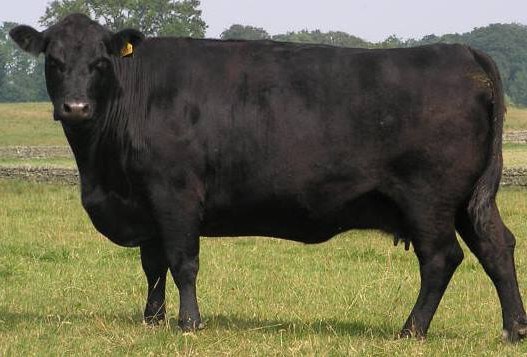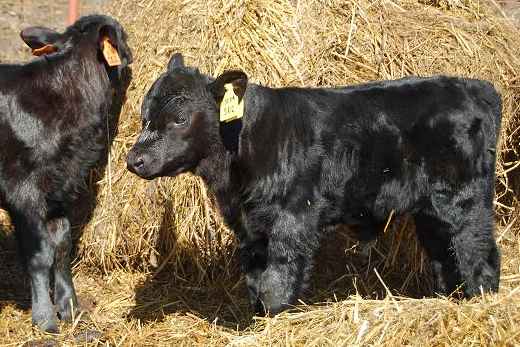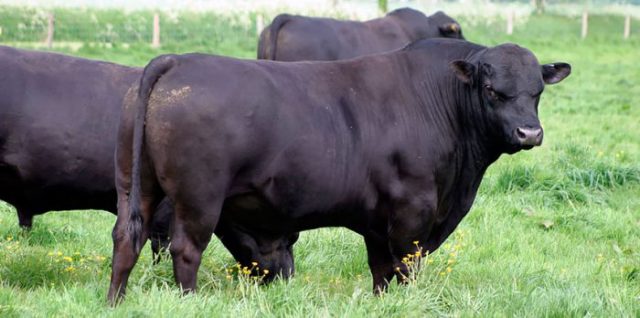Content
The Angus bull is one of the best breeds in the world for its growth rates. Among other varieties, the Aberdeen Angus breed of cows is distinguished by high quality meat products. The marbled meat of angus gobies is considered the standard.
History of breeding and distribution of the Aberdeen-Angus breed
Angus gobies were brought to Russia from Scotland. This breed got its name from the place of its original breeding - the counties of Angus and Aberdeen.
In the 19th century, breeders improved the key characteristics of these animals, after which the first purebred Angus goby herd was created. Soon the breed crossed the border of the country - a large batch was sent to the United States, where the early maturation of animals quickly gained popularity among farmers. In addition, the excellent quality of the meat produced has played a leading role in the spread of the Aberdeen-Angus breed throughout the world. Soon, Australian and non-New Zealand farmers began to buy bulls, then the breed took root in the farms of Argentina. Today, Angus calves are also bred in Russia, Canada and England.
Description of the breed of calves Aberdeen
Aberdeen Angus calves are a typical meat variety. Their milk yield is extremely low. A distinctive external feature is the hornlessness of cattle (hornlessness) and black coat color, sometimes with a brownish tint.
Exterior
The meat type of productivity is reflected in the physique of Angus gobies. The breed standard is as follows:
- The animals are quite compact. The height at the withers of an adult cow rarely exceeds 120 cm, bulls grow up to 150 cm in height. The body length reaches 130 cm in cows and 140 cm in bulls.
- The silhouette is muscular, rounded. The withers are level with the back, the sacrum and loin are even. The body is wide.
- The head of Aberdeen Angus cows is small. The forehead of animals protrudes slightly forward, the muzzle is short. The nape is narrow. There are no horns.
- The neck of the bulls is short, flowing smoothly into the shoulders.
- The color of the animals is black in most cases. Let's say the color of the coat with a brown tint.
- The chest is quite voluminous and deep.
- The limbs are a little short, but set straight.
- The skin is loose, elastic and thin, but appears thicker due to the presence of fiber underneath.
The disadvantages of the exterior include a carp-like back, saber legs and a heavy muzzle.
Productivity
The popularity of the Aberdeen Angus breed is based on its high productivity. Young Aberdeen gains weight very quickly - newborn calves weigh on average from 15 kg to 20-25 kg (heifers and bulls, respectively), however, already at the age of eight months, their weight reaches 190-200 kg. Such a rapid weight gain is due to the developed maternal instinct of Angus cows - calves grow rapidly due to prolonged feeding with mother's milk. Up to 8-9 months, gobies are raised on suction. By the time the young Aberdeen Angus are separated from their mother, the calves weigh about 220-240 kg.
Calves add 0.8 to 1 kg per day. Thus, at the age of 3 years, Aberdeen Angus bulls weigh 400-500 kg.
The live weight of an adult cow of Aberdeen Angus heifers averages 480-700 kg, in bulls this figure reaches 1 ton, especially for fattening. Neuter gobies weigh less.
The skeleton of angus gobies is thin.The skeleton is only 15-17% of the total weight of the animal. The meat is fine-fibred, tender. Its structure is characterized by a high content of fatty layers, which gives the meat an external resemblance to marble.
Distinctive features
The leading characteristic of the Aberdeen Angus breed of cows is fast fattening - Angus gobies acquire rounded shapes in the shortest possible time. In terms of early maturity, this variety is considered one of the best.
Pros and cons of breeding a breed
Before purchasing the next batch of cattle, breeders need to carefully weigh all the advantages and disadvantages of the breed in question. Careful familiarization with the features of a particular type will allow you to avoid mistakes in care and maintenance in the future. It also makes it easier to calculate the potential profit.
The positive characteristics of Angus bulls include the following qualities:
- High productivity for meat type. Slaughter from carcasses reaches 70%.
- Excellent quality of meat products. Fat in meat fibers is distributed evenly, in thin layers, without forming extensive clots. Therefore, Aberdeen Angus cows are considered the reference breed for producing excellent marbled meat. A significant part of it goes to the preparation of high quality steaks.
- Early maturity. Young growth quickly gains weight - from 150 to 200 kg in 6 months. Upon reaching the age of two, bulls and heifers are sent for slaughter.
- Longevity. Angus bulls live on average 25 to 30 years or more.
- Easy calving. In most cases, childbirth takes place without any difficulty, due to the low weight of the calves. The only exceptions are the pathologies of intrauterine development, when the size of the head of the cubs is enlarged.
- High rates of fertility. Aberdeen Angus cows are capable of producing offspring throughout their lives. Heifers become sexually mature at the age of 15 months.
- Good adaptability. Angus cows easily acclimatize on the terrain, adapting to the climatic conditions of the region. Moreover, gobies are able to safely tolerate rather low temperatures, which makes it possible to breed the breed on the territory of Russia. The herd can be kept outdoors for a significant part of the year.
- When Aberdeen Angus gobies are crossed with other species, the offspring inherit their high meat productivity. In addition, they are also impartial.
In addition, Angus cows have a rather peaceful disposition. They are calm and good-natured animals that do not show aggression without unnecessary provocation. The only exception is the increased irritability of bulls during puberty.
The list of the breed's advantages is impressive, but the Angus bull breed is not without its drawbacks. These include the following features of animals:
- Rapid weight gain can lead to serious health problems if bulls are not properly fed. Representatives of the breed often suffer from obesity, so it is not recommended to overfeed them.
- The dairy traits of Aberdeen Angus cows are very poorly developed. The average annual milk yield is at best 2 tons of milk.
- Sableness of the legs. Due to the fact that Angus gobies weigh a lot, animals often have lameness. If bulls are overfed, they may even have limb fractures.
- A heavy and massive head is also a disadvantage with the thin skeleton of Angus gobies. Its weight puts serious pressure on the cervical vertebrae of the bulls.
- Despite the fact that the Aberdeen-Angus breeds are unpretentious to the place of breeding, they are extremely demanding on the area of pastures. Angus gobies need large areas for optimal development.
Features of maintenance and care
The care of Aberdeen Angus cows is standard; these animals do not impose any special requirements on the type of feed and place of breeding. They adapt to almost any weather conditions in the area, which saves on the construction of additional buildings for keeping the herd. The productivity of Angus bulls is preserved both in hot climates and in the northern regions of the country.
General recommendations for breeding Aberdeen Angus breeds include the following points:
- For full development and weight gain, Angus bulls need loose housing.
- Walking outdoors should continue as long as possible. Feeding with fresh green food has a beneficial effect on the quality of gobies' meat products - the fatty layers in the meat fibers become thinner with this diet, which makes it more tender.
- Regular cleaning of the barn is a must. In order for angus gobies to get sick less often, it is necessary to remove manure and other debris from the premises in a timely manner. For these purposes, in large farms, the harvesting process is automated by purchasing special equipment. It removes all garbage into drains with a frequency of 1 hour.
- In many ways, the health of bulls depends on the quality of the water. It is important to keep the drinking bowls clean by removing food particles from them. The optimal frequency of changing drinking water is at least 1 time per day, preferably 2-3 times.
- Dark-colored Angus bovine hide. This leads to the fact that animals can overheat on sunny days. In this case, the herd is transferred to shaded areas near trees or large bushes. You can also build a special shed for walking your livestock.
- If it is possible to release the herd for free grazing for a significant part of the year, adults need not be fed in order to avoid obesity. They feed livestock only in the winter months, when the gobies are no longer able to independently get their food from under the thickness of the snow.
- Young animals are fattened from the first months of life. Premixes, compound feed and crushed grain can be used as supplementary feed.
- The Aberdeen Angus breed quickly weaned from humans and can seem a little shy. Sometimes wild gobies try to escape from the pasture. The problem is solved by returning such individuals to the barn, where people are in sight.
At the age of 2 years, Aberdeen Angus gobies are attracted to reproductive processes. Angus cows are highly fertile - healthy individuals give birth to offspring annually. There are usually 1-2 calves in a litter. Due to their small size, calving takes place without any problems.
Specific diseases of the breed
The Aberdeen Angus breed has excellent immunity. Angus bulls have genetically good health, as a result of which the mortality of young animals is extremely low.
The following diseases pose the greatest threat to Angus bulls:
- Dropsy of the brain (also neuropathic hydrocephalus) - the first sign of the disease is the increased size of the head of newborn calves. It is heavy and disproportionate in relation to body length. This developmental pathology significantly complicates childbirth - the large head of the fetus is almost impossible to remove from the birth canal without opening it.
- Multiple arthrogryposis - genetic pathology, as a result of which Angus calves are born with joint atrophy. Ultimately, the disease leads to the fact that the legs of the bulls are bent and twisted, and the joints become stiff.
- Notomelia - a genetic disease, which manifests itself in an increase in the number of limbs due to the inhibited growth of the main ones. An increase in additional limbs to the main ones is also possible.
- Contractual arachnodactyly - expressed in abnormal bone fragility.The skeleton of calves is very fragile, which negatively affects the development of the animal - growth slows down, and the mobility of the joints decreases.
Conclusion
Angus bull is always a profitable purchase on the farm. The Aberdeen Angus breed is one of the benchmarks for the production of marbled meat, which is used to prepare the highest quality steaks. In addition, this type of cattle is suitable for use not only for pure breeding, but also for crossing with other breeds. Calves born from such unions are distinguished by improved performance indicators and inherit the best traits of Angus.
In addition, you can learn more about the features of breeding bulls of the Aberdeen Angus breed from the video below:











